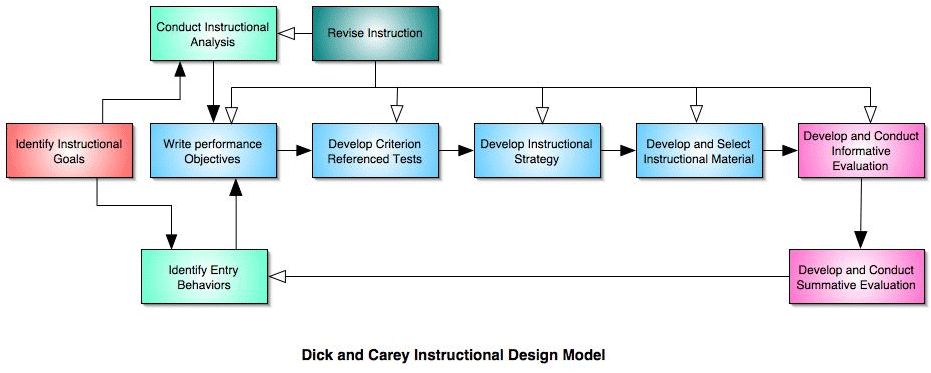Note: This site is moving to KnowledgeJump.com. Please reset your bookmark.
The Dick and Carey Model - 1978
Although there are several versions of ISD, the ADDIE model is perhaps the most popular in business and organizational environments, with the Dick and Carey model being the most popular model in schools and educational environments.
Walter Dick, Lou Carey, and James Carey developed this comprehensive and detailed process in 1978. It is composed of ten components as shown in the chart below:

-
Identify Instructional Goals - Describe what the learners are expected to perform at the end of the instruction. Instructional goals are normally broad statements of what you are trying to accomplish. They should describe what the learners should perform, not what you are going to do.
-
Conduct Instructional Analysis - Identify the exact performance gap between the present performance and the desired performance. This informs you what the learners need to learn in order to perform. Next, identify the steps the learner must be able to perform in order to accomplish the tasks that lead to the desired performance.
-
Identify Entry Behaviors - Identify the general characteristics of the learners, including skills, experience, motivation levels, and basic demographics; which relate to the skills and topics that will be taught. The information should have enough detail to allow you to identify the correct starting point of the instruction so that they do not waste time reviewing material they already know and does not omit content they need to know. The goal is to start the learning process at a level they already understand so you can scaffold the instruction by providing a structure that they can build upon.
-
Write Performance Objectives - Performance Objectives consist of a description of the task or skills to be learned, the standards or criteria, and the conditions that the task must be performed.
-
Develop Assessment Instruments - Tests and evaluations are created that will: 1) ensure the learners meet the necessary prerequisites for performing the new skills, 2) identify the learner's progress in meeting the performance objectives during the learning process, and 3) evaluate the learning process itself to ensure it is structurally sound.
-
Develop Instructional Strategy - Create a blueprint of the learning activities that will transfer, develop, and reinforce the skills and knowledge formulated in the performance objectives. Sequence the items in the blueprint in the order that will provide the best learning environment.
-
Develop and Select Instructional Materials - Using the blueprint created in the previous step, fully develop the instructional content and activities. To save time, reuse existing material whenever possible.
-
Design and Conduct Formative Evaluation - Use iterative design methods, such as prototypes, small field group trials, and/or interviews with prospective learners so that you can collect data to identify areas in the instructional material that need improvement before releasing the instruction for actual use.
-
Design and Conduct Summative Evaluation - Judge the worthiness of the entire program with the focus being on the outcome: Did it work as intended? Continue the evaluation after each class or training activity to determine if it can be approved.
-
Revise Instruction: Use the data from the two types of evaluations to examine the validity of the instructional material and revise as needed.
Next Steps
Next section: The ABCs of ISD
Return to the History of Instructional System Design
Reference
Dick, W., Carey, L. (2000). The Systematic Design of Instruction. Glenview, IL: Scott, Foresman, and Company.
